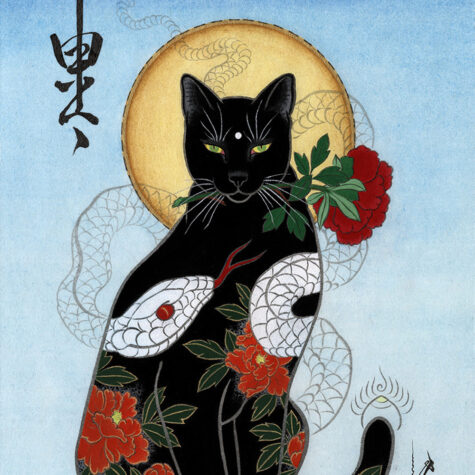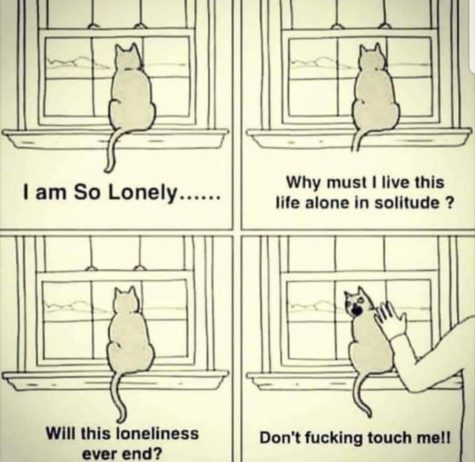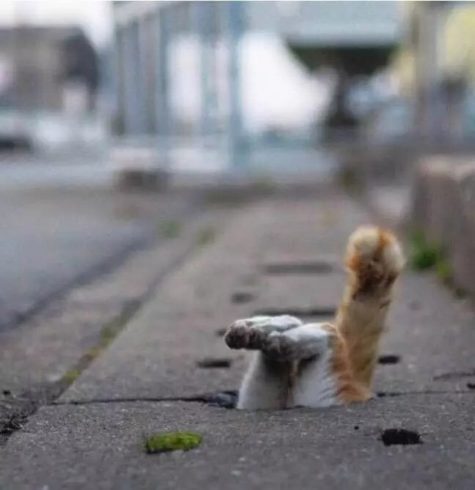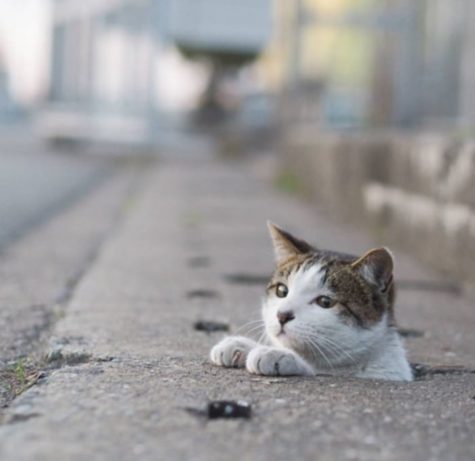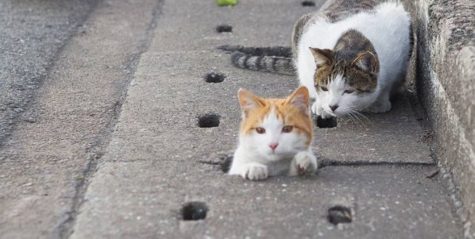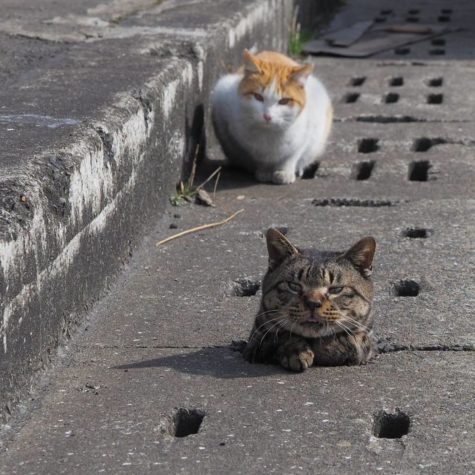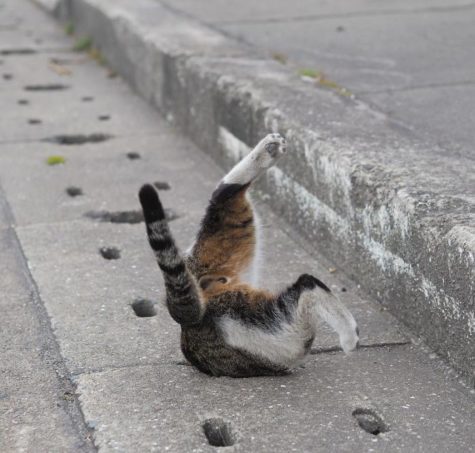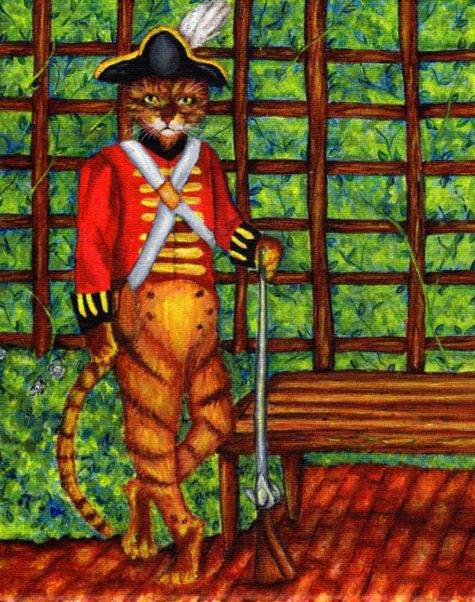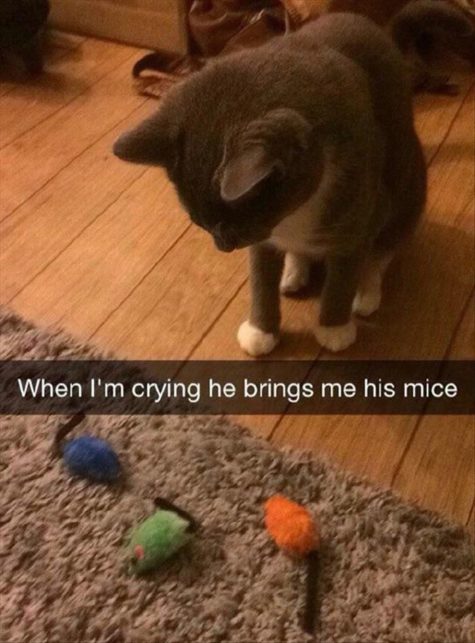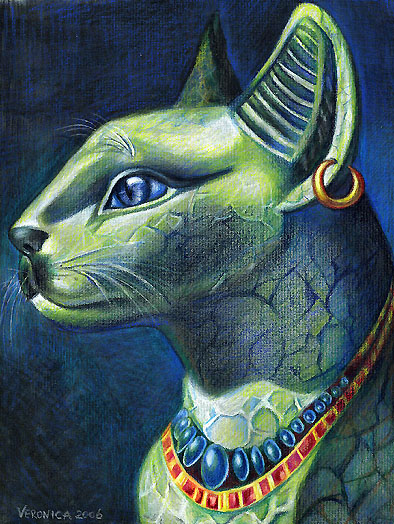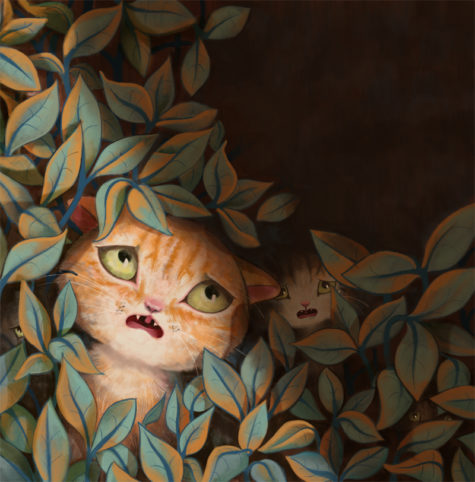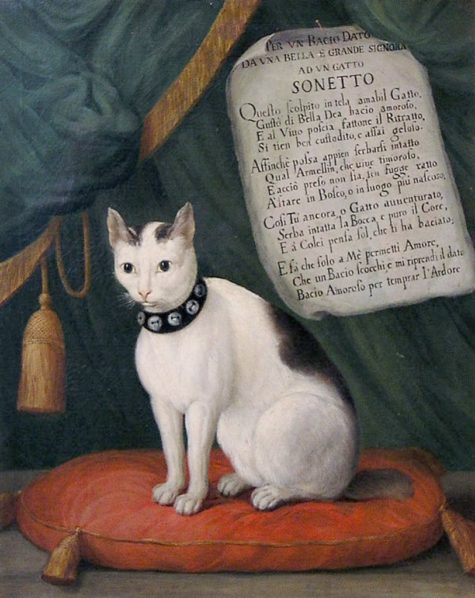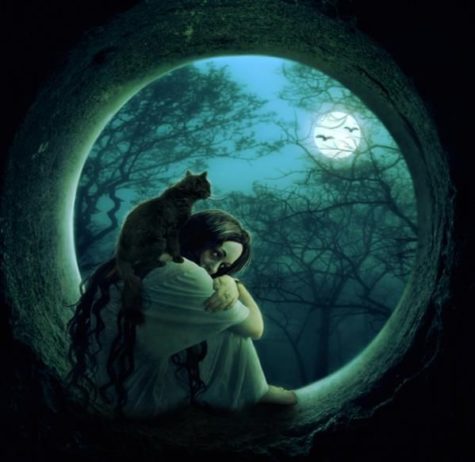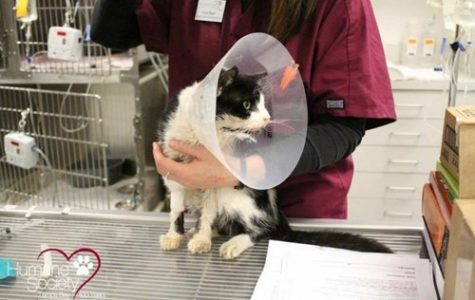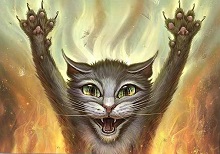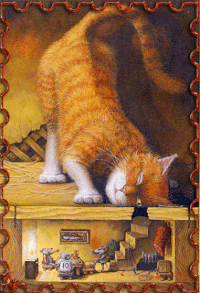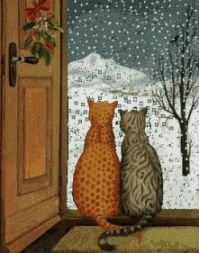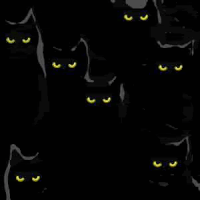True Cat Stories
Emperor Uda’s Cat
Cats have been favorites in Japan for a really long time. On March 11, 889 CE, 17-year-old Emperor Uda wrote:
“On the 6th Day of the 2nd Month of the First Year of the Kampo era. Taking a moment of my free time, I wish to express my joy of the cat. It arrived by boat as a gift to the late Emperor, received from the hands of Minamoto no Kuwashi.
“The color of the fur is peerless. None could find the words to describe it, although one said it was reminiscent of the deepest ink. It has an air about it, similar to Kanno. Its length is 5 sun, and its height is 6 sun. I affixed a bow about its neck, but it did not remain for long.
“In rebellion, it narrows its eyes and extends its needles. It shows its back.
“When it lies down, it curls in a circle like a coin. You cannot see its feet. It’s as if it were circular Bi disk. When it stands, its cry expresses profound loneliness, like a black dragon floating above the clouds.
“By nature, it likes to stalk birds. It lowers its head and works its tail. It can extend its spine to raise its height by at least 2 sun. Its color allows it to disappear at night. I am convinced it is superior to all other cats.”
The Lonely Cat
Drain Pipe Kitties
The Reincarnated Cat
Here is a true story of a cat, reputed to be the reincarnation of General Sir Thomas Edward Gordon, 1906. British Officer.
For twenty-five years an oral addition to the written standing orders of the native guard at Government House near Poona had been communicated regularly from one guard to another on relief, to the effect that any cat passing out of the front door after dark was to be regarded as His Excellency, the Governor, and to be saluted accordingly. The meaning of this was that Sir Robert Grant, Governor of Bombay, had died there in 1838 and on the evening of the day of his death a cat was seen to leave the house by the front door and walk up and down a particular path, as it had been the Governor’s habit to do after sunset.
A Hindu sentry had observed this, and he mentioned it to others of his faith, who made it a subject of superstitious conjecture, the result being that one of the priestly class explained the mystery of the dogma of the transmigration of the soul from one body to another, and interpreted the circumstance to mean that the spirit of the deceased Governor had entered into one of the house pets.
It was difficult to fix on a particular one, and it was therefore decided that every cat passing out of the main entrance after dark was to be treated with due respect and the proper honours. The decision was accepted without question by all the native attendants and others belonging to Government House. The whole guard, from sepoy to sibadar, fully acquiesced to it, and an oral addition was made to the standing orders that the sentry at the front door “present arms to any cat passing out there after dark.”
Found at: Moggycats Cat Pages
Kitty Comfort
The History Of The Domestic Cat
Our English word “cat” doesn’t seem to have come into general usage until around 300 A.D., give or take a few decades or so. It is interesting to note that several of the world’s languages call this animal by a name very similar to the English words “cat” or “puss” (which itself is believed to have derived from the name of the ancient Egyptian goddess Pasht, a cat-headed deity who was considered a darker manifestation of Bast; a.k.a.Bastet, acknowledged as the Mother of ALL cats and a goddess).
For instance, all the following examples are the words for the creature we call “cat”:
- French ~ Chat
- Welsh ~ Cath
- Arabic ~ Kitt
- Polish ~ Kot
- Syrian ~ Kato
- Sanskrit ~ Puccha
- Persia ~ Pushak
- Italian ~ Gatto
- Spanish ~ Gato
- Lithuanian ~ Puize
- German ~ Katze
- Russian ~ Kots
- Irish ~ Pus
As for the Egyptians, they called the creature Mau, meaning “to see.” No doubt the name also made onomatopoetic reference to the cat’s familiar meowing. No one really knows for certain, but it is believed that the cat may have been domesticated by these ancient Egyptians 4,000 to 5,000 years ago; relatively recent when you consider that the dog has been a companion to humans for 20,000 years, perhaps even longer. Some experts theorize that this human/dog relationship may have been going on as long as 50,000 years. As a result, the cat has retained many of its natural instincts and behaviors, having only been among humans a short while, whereas dogs have evolved right alongside us for quite some time now.
There is something about their confident personality that we admire. In fact, the ancient Egyptians were so fascinated by this detached quality of the cat that they considered them to be nothing less than godlike. To the Egyptians all cats were divine, and extreme behavior was often acted out to reinforce this conviction. For instance, if a someone happened to come across a dead cat in the street, he or she would put on a loud display of sorrow and mourning just to make sure no one thought that they were responsible for killing the cat. You see, according to Egyptian law, being found guilty of cat murder was punishable by death.
Whenever a household cat died of natural causes, the entire family would go through a period of grief, shaving their eyebrows as a mark of their sadness. Deceased cats were very often mummified and entombed with fine jewelry and treasures; a custom usually reserved for only the most powerful and wealthy of the ruling class.
But by far, the most fanatical demonstration of Egypt’s devotion to her cats occurred in 500 B.C.2 during a period of warfare with Persia. At the city of Pelusium, the Persian and Egyptian armies engaged in fierce combat, but the Egyptians resisted the onslaught with a fixed determination to save their city. The resolve of the Egyptian war machine proved too much for the rapidly tiring Persian army. Sensing ruinous defeat if the battle continued, the Persians retreated while they still could. The Egyptians knew that this wouldn’t be the end of it, so the army maintained a condition of battle readiness, waiting for the Persians to return.
What the Persians were up to was a brilliant scheme that displayed a profound understanding of their enemy’s culture and beliefs. They discovered a kink in the Egyptian armor, a weakness they would fully exploit. Night after night, the Persians deployed their elite forces to the villages and towns of the surrounding countryside, silently capturing as many cats as they could lay their hands upon. Once satisfied with the number of animals they’d collected, the Persian army returned to the city of Pelusium.
The Egyptians first noticed the distant clouds of dust, kicked up by the approaching Persian army, at dawn. The troops were readied for battle in an orderly manner, well rested and ready for combat.
Within an hour, the two armies positioned themselves in assembled ranks, glaring at each other across the battlefield. The Egyptian General signaled for the attack. In an instant, the Egyptian army charged upon the Persians who, oddly enough, held their ground. The Egyptians roared like thunder as they rapidly advanced on the Persian front line. Suddenly, there was movement within the Persian forces. Curious, but undaunted, the Egyptians continued their charge.
Then, they saw a sight that nearly froze them in their tracks. Hundreds of panic stricken cats were released upon the battlefield. The Egyptian army watched in horror as the sacred animals ran about in deadly fear.
Confusion spread through the Egyptian ranks as the Persian army seized the opportunity to take the aggressive. Advancing upon the stunned Egyptians in a evenly paced march, each of the Persian soldiers held forth a terrified cat. The Egyptians knew then and there that they were defeated.
Not a single Egyptian soldier dared to engage the enemy, fearing that to do so might endanger the lives of the cats. Without suffering a single casualty, the Persians secured their victory, devastating the Egyptians.
It has been suggested that the Egyptians initially used the cat to control the rodent population which continually destroyed crops. This seems to be a reasonable speculation, but it’s obvious that the cat meant much more to the Egyptians than that. Kingdoms don’t loose wars merely for the sake of four-legged mousetraps.
Certainly, something of the cat’s behavior suggested that a very powerful spiritual connection existed between humans, cats, and the gods. The Pharaohs and the priests alike were quite protective of their honored feline population. The distribution of cats throughout the Kingdom was carefully regulated, while exportation of cats was absolutely forbidden. Since the cat insured agricultural security by keeping away harmful pests, a surplus of goods was able to develop which gave Egypt wealth and strength, and plenty of economic clout when it came to dealing with other countries. No wonder they guarded these animals so closely. The domesticated cat was nothing less than a priceless secret weapon that contributed immeasurably to the greatness of ancient Egypt.
But eventually domesticated cats did find their way out of Egypt thanks to the Greeks who stole the animals to control their own rodent problem, and to use as powerful bargaining chips in international trade. This didn’t go over so well with the Egyptians. In fact, one Pharaoh sent out his army to various lands in a futile effort to recapture the liberated felines and return them home to Egypt.
Unfortunately for the Egyptians, it was too late. Warfare and trade had resulted in the distribution of domesticated cats throughout the Mediterranean and perhaps by this time, even as far as Asia. The Egyptian monopoly on domestic cats had at last come to an end.
Phoenician cargo ships are thought to have brought the first domesticated cats to the European continent around 900 B.C. In time, the Romans adopted the cat as a symbol of freedom and liberty. Never quite venerating felines to the extent of the Egyptians, the Romans nevertheless held the cat in high regard, and it is believed that they are responsible for introducing the cat to Britain during the course of their numerous campaigns of conquest in that region.
Over the subsequent centuries, the domesticated cat proliferated throughout Europe, the Middle East, and China. Though no longer worshiped as deities, cats were still honored and appreciated for their mousing abilities no matter where they turned up. By the 11th Century, about the time the Crusades began, cats were in huge demand since the rats were beginning to overrun the cities. Domesticated cats could now be found as far as Scotland.
While their obvious hunting abilities were being put to good use, the domesticated cat retained its mysterious, otherworldly aura of heavenly protector and benefactor.
Catholic Monasteries kept cats as guardians (that is, until the Church decided that they didn’t like cats anymore); Sailors would bring along cats during long sea voyages believing they possessed miraculous powers to protect them from dangerous weather; in a very short time, the cat spread throughout the world, becoming a treasured companion and friend.
All seemed well for these cats and the people that loved them, for a good long time in fact. Unfortunately, this was not to last. By the close of the 15th Century, Pope Innocent VIII decided that adulation for cats was tantamount to pagan worship in defiance of God. This led to the belief that cats were evil, existing solely to mislead and destroy the faithful.
The Inquisition was given instructions to hunt down all cat owners and try them as heretics and witches. For a while, cats were burned to death by the hundreds, right along side their human caretakers. The crime: “consorting with demonic forces.”
It was a far cry from their exalted days in ancient Egypt.
But cats persevered. In fact, they flourished. Centuries passed as people of various cultures spread diverse influences across the globe, while the stoic cat accompanied this progress each step of the way. And through it all, the cat has thankfully retained its independent qualities, its silent contemplative nature, its persona of supernatural wisdom.
Obviously cats won’t be leaving the scene anytime soon. They are very much a part of our our consciousness, both culturally and spiritually. Their traits are often used to describe human activities. To comment on their independence is nothing more than a safe cliché. Being such an ubiquitous animal, we tend to take them for granted, but remember this: They are the descendants of temple dwelling cats, domesticated by the Egyptians and regarded as sacred. To ignore their unique lineage is to sever all metaphorical links to our mystic past, and this would indeed be a tragedy.
Found at: Low Chen’s Australia
Bart The Zombie Cat
‘Zombie Cat’ Hit By Car and Buried, Comes Back 5 Days Later!
Bart the cat was hit by a car in Tampa, Florida on January 17 and thought to be dead by his owner in Florida. He was found in the street in a pool of blood and buried.
Five days later, he showed up in their neighbor’s yard very much alive.
“I saw him with my own eyes. I know he was dead. He was cold and stiff,” the neighbor told ABC News.
They took him to the vet after his “resurrection” (maybe they should have done this before burying him?) where he was treated for a broken jaw, open facial wounds and a ruined eye.
“We have seen many amazing cases at our full-service veterinary clinic,” wrote the Humane Society of Tampa on its website. “But this situation may take the cake!”
A GoFundMe page was set up by the neighbor to raise money for Bart’s medical costs. The Humane Society posted an updated on his condition on Facebook.
Bart The Miracle Cat has successful surgery! He was a brave boy and is now resting comfortably. He is spending the night with our good friends at Tampa Bay Veterinary Emergency Service so he can be monitored. He will return to us in the morning and need a week or so to recover before going back home!
Note: This is old news, happened back in 2015… but still interesting!
Via The Daily What
